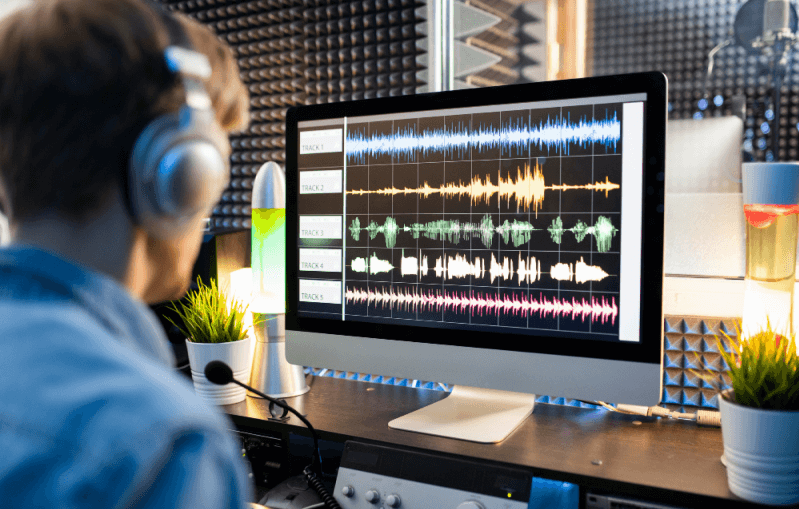Why audio visual charlotte nc is the backbone of well-executed events
Wiki Article
Comprehending the Incorporation of Audio Visual Innovation in Today's Educational Environments
The combination of audio-visual technology in instructional setups has changed the training and learning process. Educators now have accessibility to tools that deal with various learning styles, improving pupil involvement and collaboration. The unification of these modern technologies offers both chances and challenges. Recognizing how to properly execute these devices is vital. What techniques can instructors utilize to optimize the advantages of audio-visual modern technology in their classrooms?The Development of Audio-Visual Technology in Education
As academic requirements advanced over the years, audio-visual technology went through significant makeovers that reshaped the understanding environment. Devices such as movie projectors and slide shows were the primary means of integrating visual elements right into class. These very early modern technologies given educators with the ability to existing details dynamically, yet they were limited in access and interactivity.With the introduction of videotape recorder in the 1970s, classrooms began to integrate taped lessons, expanding the range of academic sources. The introduction of computers in the 1980s further reinvented this landscape, enabling the production of multimedia presentations and interactive knowing experiences.
The increase of the net in the 1990s noted a turning point, enabling real-time accessibility to a riches of audio-visual materials. Today, digital devices such as interactive whiteboards and on the internet understanding platforms continue to improve the educational experience, fostering engagement and partnership among learners.
Advantages of Audio-Visual Devices for Diverse Knowing Styles
Audio-visual tools play an essential function in dealing with diverse understanding designs by enhancing visual knowing and enhancing acoustic involvement. By incorporating photos, videos, and noise, these modern technologies create a more inclusive instructional environment. This multifaceted approach allows educators to deal with the diverse choices and requirements of pupils properly.Enhancing Visual Discovering
Interaction in the discovering process is considerably improved via making use of audio-visual devices, catering to different discovering designs. These tools, such as video clips, infographics, and interactive discussions, offer aesthetic stimuli that help understanding and retention. Aesthetic learners, in specific, advantage from the unification of images and animations, which can streamline intricate principles and improve understanding. Additionally, audio-visual resources can show real-world applications, making discovering more pertinent and appealing. By integrating shade, movement, and noise, educators can develop a dynamic discovering setting that captures pupils' attention and promotes much deeper cognitive connections. Inevitably, the critical use audio-visual technology not just supports aesthetic learning however also improves the total educational experience for varied students.Improving Auditory Interaction
A considerable benefit of including audio-visual devices in education is their capacity to improve auditory engagement amongst pupils. These devices, which include multimedia presentations, podcasts, and interactive sound components, satisfy various learning styles, especially profiting acoustic learners (audio visual charlotte nc). By integrating noise and narration, instructors can produce immersive experiences that catch students' attention and reinforce comprehension. This involvement is crucial, as it fosters a much deeper understanding of the material and advertises retention. In addition, audio-visual tools can help with joint discovering settings, encouraging trainees to get involved in conversations and share their insights. Inevitably, the consolidation of audio-visual modern technology not just sustains auditory engagement however likewise enhances the overall academic experience, making discovering more vibrant and reliable for all traineesEnhancing Involvement With Interactive Learning

Moreover, gamification elements, such as tests and simulations, can boost inspiration and retention, making discovering more delightful and effective. These strategies not just stimulate cognitive involvement however additionally accommodate diverse learning styles, ensuring that all trainees can get involved meaningfully. Consequently, interactive understanding settings promote a sense of neighborhood and belonging, inevitably leading to boosted scholastic end results. With the combination of audio visual modern technology, instructors can change conventional classrooms right into vivid areas where pupils grow and actively shape their educational journeys.
Linking Theory and Practice With Multimedia Resources
Multimedia resources function as a crucial web link between academic principles and practical application in educational setups. By boosting interaction, facilitating collective knowing experiences, and supporting diverse understanding designs, these tools create a more inclusive and dynamic understanding setting - audio visual charlotte nc. This technique not just promotes much deeper understanding yet also prepares students for real-world obstacles
Enhancing Interaction With Multimedia
Interaction in academic settings considerably boosts when teachers integrate multimedia resources into their training strategies. Making use of video clips, podcasts, and interactive discussions boosts the learning experience, permitting trainees to get in touch with the material on several degrees. Multimedia resources satisfy different discovering designs, providing aesthetic, auditory, and kinesthetic stimuli that can hold pupils' attention extra properly than traditional lecture approaches. Additionally, these resources can streamline complex concepts, read this making them more easily accessible and memorable. By incorporating multimedia, educators can create a dynamic class environment that fosters interest and motivates students. Inevitably, the strategic use of audio-visual modern technology serves to link the gap in between academic knowledge and sensible application, enriching the academic experience for both instructors and trainees.Facilitating Collaborative Understanding Experiences
Many researches suggest that collaborative discovering experiences considerably enhance student results when incorporated with multimedia sources. Multimedia tools promote interaction amongst trainees, allowing them to take part in analytical and crucial assuming collectively. By utilizing video conferencing, joint systems, and interactive discussions, educators produce atmospheres favorable to team effort and shared understanding. These modern technologies allow pupils to connect their ideas properly and receive instant responses, promoting a deeper understanding of the topic. In addition, multimedia resources can offer complicated principles in even more digestible layouts, promoting discussion and collaboration. Consequently, the combination of collective understanding and audio-visual innovation not just enhances the academic experience but additionally prepares trainees for real-world teamwork dynamics, emphasizing the relevance of teamwork and cumulative knowledge building.Sustaining Diverse Knowing Styles
While typical training techniques typically deal with a restricted series of finding out choices, the combination of audio-visual technology provides an extra inclusive method to education. By utilizing multimedia resources such as video clips, interactive simulations, and digital presentations, educators can deal with different learning styles, consisting of aesthetic, acoustic, and kinesthetic. This adaptability enables separated direction, enabling trainees to involve with content in manner ins which resonate with their private preferences. Additionally, audio-visual devices can assist in deeper understanding by providing multiple representations of complicated concepts. Consequently, trainees that might have problem with traditional techniques can discover alternative paths to success, cultivating a more equitable knowing setting that supports scholastic accomplishment for all students.Obstacles in Carrying Out Audio-Visual Innovation
Although audio-visual innovation holds fantastic pledge for enhancing instructional experiences, its execution commonly encounters significant difficulties. One primary issue is the economic problem related to investing in and preserving such equipment, which can strain budgets, especially in underfunded institutions. Additionally, insufficient training for instructors can impede effective assimilation, leaving them ill-prepared to utilize the technology fully. Technical problems, such as software program breakdowns and compatibility troubles, might also interrupt lessons and annoy both educators and trainees. Differing levels of pupil access to technology outside the classroom can create variations in finding out chances. Ultimately, the capacity for over-reliance on technology may interfere with essential teaching methods, eventually restricting the educational experience. Dealing with these obstacles needs a complete method, consisting of ample financing, professional development, and equitable accessibility to sources, to guarantee that audio-visual innovation can be leveraged efficiently in today's educational settings.Best Practices for Integrating Technology in the Class

In addition, fostering an interactive atmosphere with collective tools encourages pupil involvement and engagement. Making use find of varied audio-visual resources caters to various discovering styles, accommodating aesthetic, auditory, and kinesthetic students. Regularly reviewing the impact of modern technology on pupil discovering aids educators refine their techniques and adjust to changing requirements. Entailing pupils in the choice of modern technology advertises possession and motivation. By adhering to these best techniques, instructors can develop a dynamic classroom environment that efficiently integrates technology and improves the instructional experience for all students.
The Future of Audio-Visual Innovation in Education And Learning
As class significantly embrace innovation, the landscape of audio-visual tools in education and learning remains to advance (audio visual charlotte nc). Future improvements are anticipated to concentrate on higher interactivity and personalization, allowing get more instructors to tailor discovering experiences to specific trainee demands. Advancements such as enhanced truth (AR) and digital fact (VR) will likely supply immersive learning settings, improving trainee interaction and understanding
Synthetic knowledge (AI) is positioned to play a substantial duty in audio-visual innovation by providing real-time responses and adaptive knowing pathways. This combination might help instructors identify and address trainee obstacles much more properly. Cloud-based platforms will certainly help with easier accessibility to sources and partnership among trainees and teachers, no matter location.
In enhancement to these technological advances, expert advancement for instructors will be essential, ensuring they are equipped to make use of these devices properly. In general, the future of audio-visual modern technology in education guarantees to produce more vibrant, comprehensive, and impactful knowing experiences.
Regularly Asked Inquiries
Just How Can Teachers Choose the Right Audio-Visual Tools for Their Class?
Picking ideal audio-visual devices requires instructors to examine their educational goals, think about trainee demands, evaluate offered technology, and look for recommendations from peers or specialists, guaranteeing tools efficiently boost discovering and engagement within their details classroom environment.What Budget plan Factors to consider Are There for Carrying Out Audio-Visual Modern Technology?
Budget plan factors to consider for applying audio-visual innovation include initial purchase costs, upkeep costs, training for staff, and prospective software program licensing charges. Furthermore, lasting investment in updates and replacements ought to also be factored right into financial preparation.Exist Certain Training Resources for Educators on Audio-Visual Devices?
Lots of institutions supply training resources for educators on audio-visual devices, consisting of on the internet programs, workshops, and instructional overviews. These resources aim to improve instructors' skills and confidence in successfully incorporating innovation into their training practices.How Do We Gauge the Efficiency of Audio-Visual Modern Technology in Knowing?
Gauging the efficiency of audio-visual technology in learning includes assessing student involvement, comprehension, retention rates, and general academic efficiency. Surveys, evaluations, and empirical research studies can provide valuable insights right into its effect on instructional end results.What Prevail False Impressions Regarding Audio-Visual Modern Technology in Education And Learning?
Usual misconceptions about audio-visual modern technology in education consist of the idea that it assures engagement and learning results, as well as the presumption that all trainees benefit just as, neglecting specific discovering choices and demands.Report this wiki page